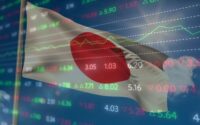Fed Chair Powell calls talk of cutting rates ‘premature’ and says more hikes could happen
Federal Reserve Board Chairman Jerome Powell speaks during a news conference after a Federal Open Market Committee meeting on September 20, 2023 at the Federal Reserve in Washington, DC.
Chip Somodevilla | Getty Images
Federal Reserve Chairman Jerome Powell on Friday pushed back on market expectations for aggressive interest rate cuts ahead, calling it too early to declare victory over inflation.
Despite a string of positive indicators recently regarding prices, the central bank leader said the Federal Open Market Committee plans on “keeping policy restrictive” until policymakers are convinced that inflation is heading solidly back to 2%.
“It would be premature to conclude with confidence that we have achieved a sufficiently restrictive stance, or to speculate on when policy might ease,” Powell said in prepared remarks for an audience at Spelman College in Atlanta. “We are prepared to tighten policy further if it becomes appropriate to do so.”
However, he also noted that policy is “well into restrictive territory” and noted that balance of risks between doing too much or too little on inflation are close to balanced now.

Markets moved higher following Powell’s remarks, with major averages positive on Wall Street and Treasury yields sharply lower.
“Markets view today’s comments as inching toward the dovish camp,” said Jeffrey Roach, chief economist at LPL Financial.
Expectations that the Fed is done raising rates and will move to an easing posture in 2024 have helped underpin a strong Wall Street rally that has sent the Dow Jones Industrial Average up more than 8% over the past month to a new 2023 high.
Powell’s remarks gave some credence to the idea that the Fed at least is done hiking as the string of rate hikes since March 2022 have cut into economic activity.
“Having come so far so quickly, the FOMC is moving forward carefully, as the risks of under- and over-tightening are becoming more balanced,” he said.
“As the demand- and supply-related effects of the pandemic continue to unwind, uncertainty about the outlook for the economy is unusually elevated,” he added. “Like most forecasters, my colleagues and I anticipate that growth in spending and output will slow over the next year, as the effects of the pandemic and the reopening fade and as restrictive monetary policy weighs on aggregate demand.”
A Commerce Department report Thursday showed that personal consumption expenditures prices, the Fed’s preferred inflation gauge, were up 3% from a year ago, but 3.5% at a core basis that excludes volatile food and energy prices. Recent sharp declines in energy have been responsible for much of the easing in inflation.
Powell said the current levels are still “well above” the central bank’s goal. Noting that core inflation has run at a 2.5% annual rate over the past six months, Powell said, “while the lower inflation readings of the past few months are welcome, that progress must continue if we are to reach our 2 percent objective.”
“Inflation is still running well above target, but it’s moving in the right direction,” he said. “So we think the right thing to be doing now is to be moving carefully, thinking carefully about about how things are going on letting letting the data tell us what the story is. The data will tell us whether we’ve done enough or whether we need to do more.”
After inflation hit its highest level since the early 1980s, the Fed enacted a series of 11 interest rate hikes, taking its policy rate to the highest in 22 years at a target range between 5.25%-5.5%. The FOMC at its past two meetings kept rates level, and multiple officials have indicated they think the federal funds rate is probably at or near where it needs to be.
The Fed’s next meeting is Dec. 12-13.
“The strong actions we have taken have moved our policy rate well into restrictive territory, meaning that tight monetary policy is putting downward pressure on economic activity and inflation,” Powell said. “Monetary policy is thought to affect economic conditions with a lag, and the full effects of our tightening have likely not yet been felt.”
Traders expect cuts
Market pricing Friday morning indicated that the Fed indeed is done hiking and could start cutting as soon as March 2024, according to the CME Group. Moreover, futures are pointing to cuts totaling 1.25 percentage points by the end of the year, the equivalent of five quarter percentage point reductions.
However, neither Powell nor any of his fellow officials have provided any indication that they’re thinking about cuts, with the chair adhering to data dependence for future decisions rather than any preset course.
“We are making decisions meeting by meeting, based on the totality of the incoming data and their implications for the outlook for economic activity and inflation, as well as the balance of risks,” Powell said.
Addressing the economic data, Powell characterized the labor market as “very strong,” through he said a reduced pace of job creation is helping bring supply and demand back in line.
[ad_2]
Source link


